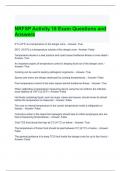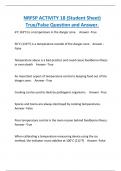Nrfsp activity Study guides, Class notes & Summaries
Looking for the best study guides, study notes and summaries about Nrfsp activity? On this page you'll find 149 study documents about Nrfsp activity.
Page 2 out of 149 results
Sort by
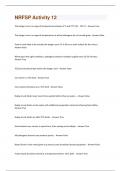
-
NRFSP Activity 12 Questions With 100% Solved Solutions!!
- Exam (elaborations) • 2 pages • 2024
- Available in package deal
-
- $7.39
- + learn more
The danger zone is a range of temperatures between 5°C and 57°C (41 - 135 F°) - Answer-True The danger zone is a range of temperatures at which pathogens do nut usually grow - Answer-False Food is most likely to be outside the danger zone if it is left on a work surface for four hours. - Answer-False When given the right conditions, pathogenic bacteria multiply roughly every 10-20 minutes. - Answer-True TCS food should be kept within the danger zone - Answer-False Cut melon is a TCS fo...
NRFSP Activity 18 Exam Questions and Answers
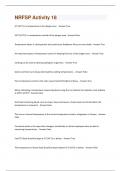
-
NRFSP Activity 18 (Questions & Answers) Verified 100% Correct!!
- Exam (elaborations) • 2 pages • 2024
- Available in package deal
-
- $7.69
- + learn more
6°C (43°F) is a temperature in the danger zone. - Answer-True 56°C (133°F) is a temperature outside of the danger zone - Answer-False Temperature abuse is a bad practice and could cause foodborne illness or even death - Answer-True An important aspect of temperature control is keeping food out of the danger zone. - Answer-True Cooking can be used to destroy pathogenic organisms. - Answer-True Spores and toxins are always destroyed by cooking temperatures. - Answer-False Poor temperatur...
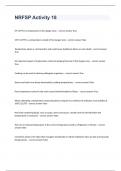
-
NRFSP Activity 18 Question and answers rated A+ 2024
- Exam (elaborations) • 2 pages • 2024
-
Available in package deal
-
- $15.49
- + learn more
NRFSP Activity 18 Question and answers rated A+ 2024 NRFSP Activity 18 6°C (43°F) is a temperature in the danger zone. - correct answer True 56°C (133°F) is a temperature outside of the danger zone - correct answer False Temperature abuse is a bad practice and could cause foodborne illness or even death - correct answer True An important aspect of temperature control is keeping food out of the danger zone. - correct answer True Cooking can be used to destroy pathogenic organ...

-
NRFSP Activity 18 Questions and Answers | 100% Pass
- Exam (elaborations) • 2 pages • 2024
- Available in package deal
-
- $10.49
- + learn more
NRFSP Activity 18 Questions and Answers | 100% Pass 6°C (43°F) is a temperature in the danger zone. -Answer-True 56°C (133°F) is a temperature outside of the danger zone -Answer-False Temperature abuse is a bad practice and could cause foodborne illness or even death - Answer-True An important aspect of temperature control is keeping food out of the danger zone. - Answer-True Cooking can be used to destroy pathogenic organisms. -Answer-True Spores and toxins are always destroyed by ...
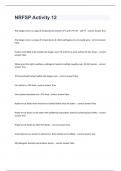
-
NRFSP Activity 12 Question and answers 100% correct 2024
- Exam (elaborations) • 2 pages • 2024
-
Available in package deal
-
- $14.99
- + learn more
NRFSP Activity 12 Question and answers 100% correct 2024 NRFSP Activity 12 The danger zone is a range of temperatures between 5°C and 57°C (41 - 135 F°) - correct answer True The danger zone is a range of temperatures at which pathogens do nut usually grow - correct answer False Food is most likely to be outside the danger zone if it is left on a work surface for four hours. - correct answer False When given the right conditions, pathogenic bacteria multiply roughly every 10-20 ...
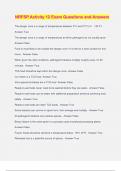
-
NRFSP Activity 12 Exam Questions and Answers
- Exam (elaborations) • 1 pages • 2024
- Available in package deal
-
- $9.49
- + learn more
NRFSP Activity 12 Exam Questions and Answers The danger zone is a range of temperatures between 5°C and 57°C (41 - 135 F°) - Answer-True The danger zone is a range of temperatures at which pathogens do nut usually grow - Answer-False Food is most likely to be outside the danger zone if it is left on a work surface for four hours. -Answer-False
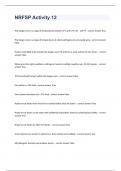
-
NRFSP Activity 12 correctly answered 2024/2025
- Exam (elaborations) • 2 pages • 2024
-
Available in package deal
-
- $9.99
- + learn more
NRFSP Activity 12The danger zone is a range of temperatures between 5°C and 57°C (41 - 135 F°) - correct answer True The danger zone is a range of temperatures at which pathogens do nut usually grow - correct answer False Food is most likely to be outside the danger zone if it is left on a work surface for four hours. - correct answer False When given the right conditions, pathogenic bacteria multiply roughly every 10-20 minutes. - correct answer True TCS food should be kept withi...
NRFSP ACTIVITY 18 (Student Sheet) True/False Question and Answer.
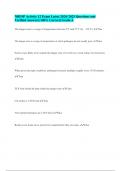
-
NRFSP Activity 12 Exam Latest 2024/ 2025 Questions and Verified Answers| 100% Correct| Grade A
- Exam (elaborations) • 2 pages • 2024
- Available in package deal
-
- $9.48
- + learn more
NRFSP Activity 12 Exam Latest 2024/ 2025 Questions and Verified Answers| 100% Correct| Grade A The danger zone is a range of temperatures between 5°C and 57°C (41 - 135 F°) True The danger zone is a range of temperatures at which pathogens do nut usually grow False Food is most likely to be outside the danger zone if it is left on a work surface for four hours. False When given the right conditions, pathogenic bacteria multiply roughly every 10-20 minutes. True TCS food should be kept...

$6.50 for your textbook summary multiplied by 100 fellow students... Do the math: that's a lot of money! Don't be a thief of your own wallet and start uploading yours now. Discover all about earning on Stuvia

